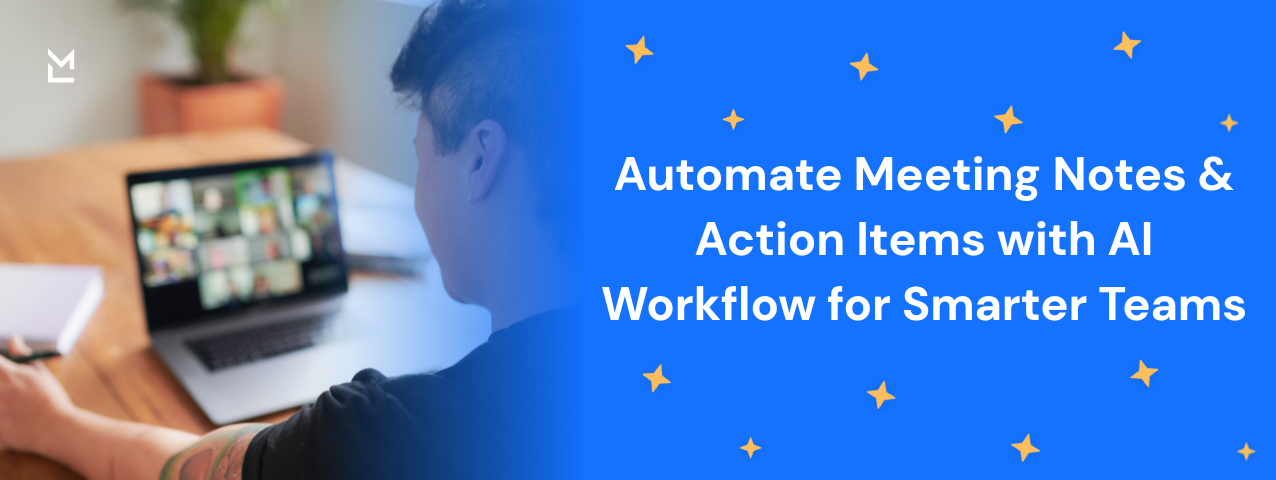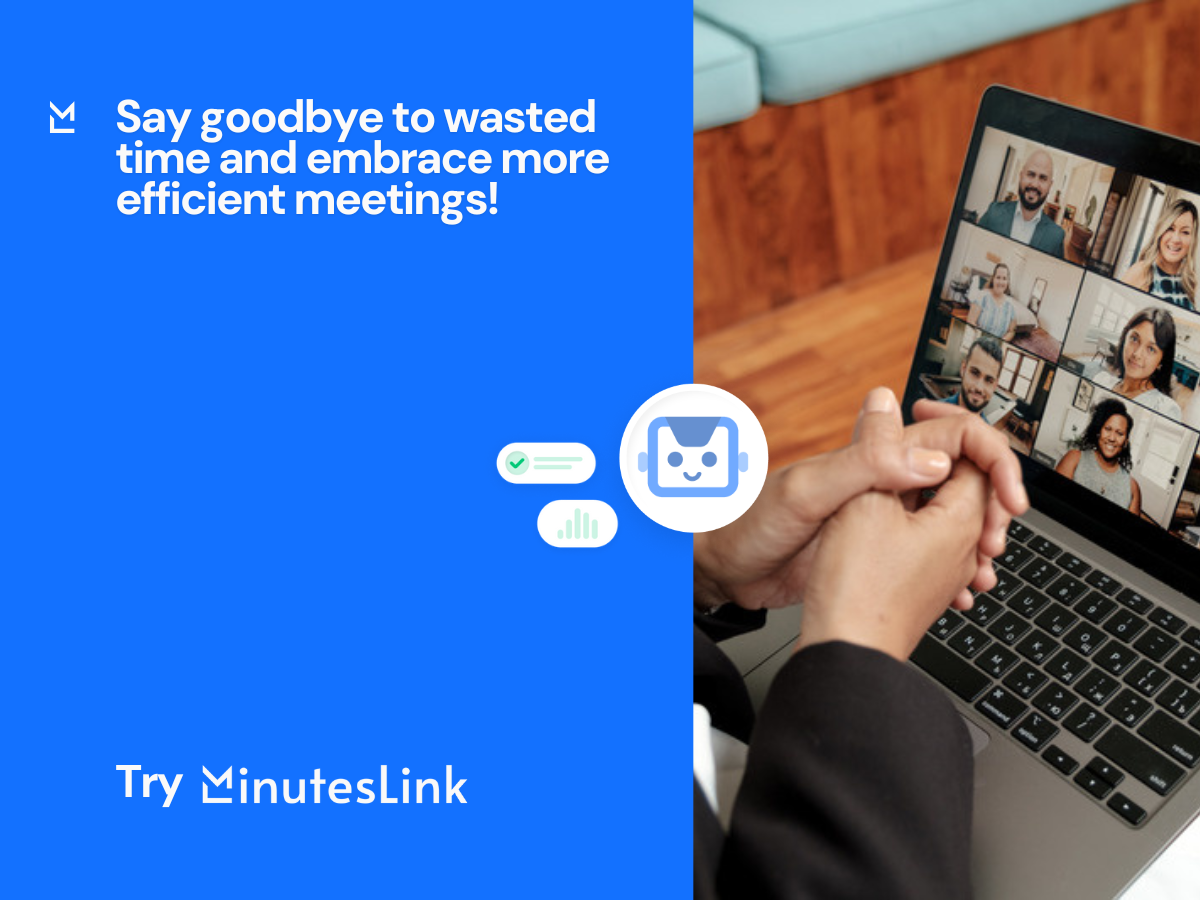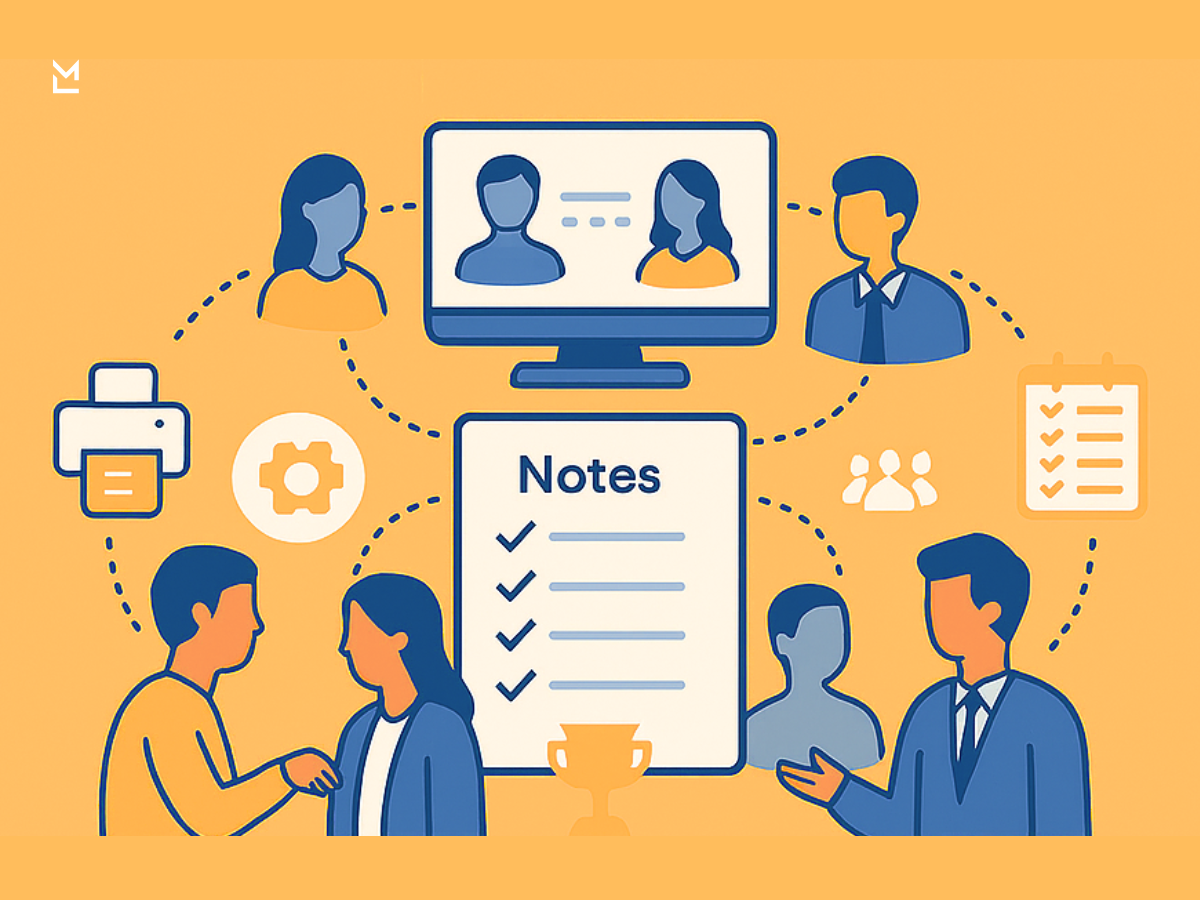
Written with help from MinutesLink - free AI meeting notetaker for online meetings.
Written with support from MinutesLink — a free AI notetaker for online meetings.
Let’s be honest: taking great meeting notes is a skill - and a tedious one. In fast-paced discussions, ideas fly, decisions overlap, and by the end, everyone assumes “someone” got it all down. That “someone” usually didn’t.
Manual note-taking also breaks your focus. When you’re half-listening, half-typing, you lose context and nuance. Later, when you revisit your messy notes, you realize half the action items are missing or unclear. Multiply that by five meetings a day, and your workflow starts to drown in unfinished threads.
AI-driven automation tools fix this elegantly. Modern ai workflow automation systems can join your call, record, transcribe, summarize, and even flag action items as the conversation unfolds. It’s not just convenient - it’s a small miracle of artificial intelligence meeting real human frustration. Tools like MinutesLink make this process even easier, turning live meetings into structured meeting notes and automatically identifying action items for your team.
At the heart of it all lies one thing: prompts.
Think of an AI workflow prompt as a clear instruction set you give your system. Instead of saying, “Summarize this meeting,” you tell it how to summarize - what to look for, what format to use, and how to tag tasks.

When done right, these prompts create an invisible assistant who not only listens but truly understands your meeting processes. It identifies action items, organizes them into structured workflows, and passes them into your automation tools or project management dashboards with remarkable accuracy.
The result is a seamless bridge between conversation and execution.
Picture this: You’ve just finished your weekly strategy meeting. The AI assistant - let’s call it Mira - automatically processes the transcript. Within minutes, your inbox holds a beautifully formatted summary:
No typing, no guessing, no lost tasks. Just structured clarity that moves your projects forward.
That’s the power of a good ai workflow combined with thoughtful automation - a quiet transformation that turns chaos into order.
A prompt isn’t magic by itself. It’s the design behind it that determines how your AI automation behaves. A strong workflow prompt:
When your instructions are crisp, the AI produces meeting notes and action items that feel like they were written by a person who was paying full attention - not a robot grabbing random keywords.
Once the AI captures your meeting notes, it extracts every commitment that starts with “I will,” “We need to,” or “Let’s make sure.” Those phrases become action items.
Then comes the automation magic:
You’ve effectively created a digital assistant who listens, organizes, and keeps everyone accountable.
It’s not just about saving time (though you will save time, plenty of it). It’s about building reliability into how your team operates. With AI doing the repetitive heavy lifting, your team members can focus on collaboration, strategy, and creativity - things no machine can replicate.

Companies that implement ai workflow automation tools report clearer communication, fewer missed deadlines, and smoother workflow management overall. It’s like having a built-in memory for your business conversations.
And as your business processes grow more complex, this structure becomes essential. Automated workflows ensure that decisions don’t disappear in a sea of meetings.
Every successful AI-driven meeting process has three steady steps:
Once this loop is set up, it runs quietly in the background - no extra clicks, no forgotten follow-ups.
One of the biggest misconceptions about automation tools is that they make work robotic. In truth, good automation makes work more human. It removes the drudgery - the repetitive tasks, the endless note-taking, the manual copy-pasting - so people can spend time on creative and strategic thinking.
When your team members aren’t bogged down in logistics, they start asking better questions, spotting bottlenecks, and driving innovation. That’s real boosting productivity, not the performative kind.
Early adopters often face the same few hiccups. Sometimes the AI misses a specific task, or assigns the wrong owner, or the meeting notes feel too generic. That’s normal.
The trick is to refine your prompts. Be explicit. If you need action items with deadlines, tell the AI to “add dates.” If you want task assignments by role, specify “assign each action item to a person mentioned.”

Small adjustments make a big difference. Over time, your AI learns the language of your company and adapts.
Modern teams live across many platforms - Slack, Notion, ClickUp, Google Drive, Microsoft Teams, and countless others. The beauty of ai workflow automation is how easily it connects them.
You can have your meeting notes saved in Notion, action items logged in Asana, and progress updates posted back into Teams. Platforms such as MinutesLink seamlessly connect with these tools, ensuring that all tasks and workflows are automatically synced and tracked. The flow is invisible but powerful, linking conversations, decisions, and execution into one cohesive stream.
This interoperability is what turns isolated processes into living workflows.
While every organization’s experience will differ, here’s what most teams notice within weeks of switching to AI-driven workflow management:
Those are simple, human outcomes - and they matter more than any technical feature list.
Once the basics run smoothly, your AI system can handle even more complex tasks - things like generating project briefs, summarizing cross-departmental updates, or identifying recurring themes across multiple meetings.
It’s the next evolution of workflow optimization: turning unstructured talk into structured insight. Over time, your database of meeting notes becomes a searchable history of how your company thinks, decides, and grows.

That’s invaluable knowledge - the kind of institutional memory most organizations dream of.
Ten years ago, automation meant scripts and code. Today, it’s prompts and language. AI workflow automation lets you speak naturally - “Summarize our product meeting and assign next steps” - and the system just does it.
In the near future, we’ll see even tighter integration between collaboration tools, project management, and voice-based AI. You might end a call, say “Mira, send out the summary and assign the tasks,” and everything is instantly done - including sending notifications and updating dashboards.
That’s the beauty of human-centered technology: it bends to how we work, not the other way around.
No automation system works without trust. Teams need to believe that the AI isn’t here to replace them, but to help them manage their workflows more efficiently.
If you’re introducing this at your company, communicate openly. Explain the key benefits: fewer errors, faster follow-ups, and less administrative noise. Encourage feedback. Involve people in crafting the prompts - after all, they know their tasks best.
That’s how you get genuine buy-in and long-term adoption.
When you consistently use AI to capture meeting notes and translate them into action items, something subtle but powerful happens - accountability becomes cultural. People begin to show up differently. They know their commitments will be tracked, not forgotten.
And with that clarity, teams stop dreading meetings. Instead, meetings become the heartbeat of real work - short, focused, and impactful.

This shift ripples through the entire organization: fewer delays, better communication, more aligned priorities, and overall higher productivity.
I recently worked with a small marketing agency that struggled to keep up with its client deliverables. Their weekly meetings were lively, full of ideas - but also full of missed follow-ups.
We introduced a simple ai workflow: automatic transcription, a clear meeting notes template, and one custom prompt to identify action items and assign owners.
Within a month, they’d shortened their average project turnaround by 20%. Nothing magical - just clarity.
The same story repeats in product teams, sales departments, startups, and even non-profits. The formula holds because it’s rooted in human psychology: when expectations are visible, accountability naturally follows.
There’s a temptation to over-engineer everything - to add more tools, more automation, more dashboards. Resist that urge.
Start simple. Automate only what’s truly repetitive or high-volume. Let people handle nuance, negotiation, and creativity. Automation should support humans, not replace their judgment.
Your ai workflow automation setup should feel like an invisible hand - quietly smoothing the path, not building another maze.
Tracking success doesn’t mean drowning in metrics. Instead, focus on what your team actually feels and achieves. Ask:
If yes, your workflow automation is working. Over time, you can layer in more data - completion rates, turnaround time, or the number of automated workflows triggered - but never lose sight of the human experience behind the numbers.
When you combine thoughtful AI workflow prompts, a few reliable automation tools, and a culture of clarity, you don’t just improve meeting notes - you transform how your entire organization communicates.

Meetings stop being time drains and start being engines of momentum. Action items stop slipping through cracks. Tasks get completed, progress is visible, and everyone feels aligned.
That’s the quiet revolution happening right now in workflow management. It’s not about flashy technology - it’s about people working better together, powered by tools that finally understand how humans actually collaborate.
If meetings are where decisions happen, then AI workflow automation is how those decisions come to life. Use it thoughtfully, keep it human, and let the machines handle the repetitive tasks like note-taking, tracking action items, and assigning responsibilities, so your team can focus on creating, deciding, and moving projects forward.
MinutesLink makes this effortless. By turning meeting notes into structured workflows and automatically managing tasks, it ensures nothing gets lost, deadlines are clear, and progress is visible in real time - helping your team stay aligned, productive, and focused on outcomes rather than admin.
Taking meeting notes isn’t about writing down every word - it’s about capturing the decisions, key points, and next steps. Focus on what matters: who said what, important ideas, and assigned responsibilities. Use headings, bullet points, or tables to keep notes clear. Sharing them immediately after the meeting ensures everyone stays aligned. Tools like MinutesLink or AI assistants can even help automate this, so nothing gets lost.
Workflow management is the way teams organize, track, and optimize how tasks move from start to finish. It ensures work doesn’t get stuck, responsibilities are clear, and deadlines are met. Think of it like a roadmap for your team’s work: visualizing processes, automating repetitive steps, monitoring progress, and continuously improving efficiency. It keeps your team aligned and productive.
Action items are the tangible next steps that come out of meetings or projects. They’re specific tasks someone is responsible for, usually with a deadline. For example, instead of “Discuss marketing strategy,” an action item would be: “Jane will draft a social media content plan by Friday.” Action items turn conversations into real work and ensure decisions actually get done.
Task automation is using tools or software to handle repetitive or routine tasks automatically. This can be as simple as sending reminders, updating project statuses, or moving tasks between boards. The goal is to free your team from mundane work so they can focus on strategic and creative tasks. In meetings, automation can automatically capture notes, assign action items, and track progress.
An AI workflow is a process where artificial intelligence helps manage tasks, decisions, and communication in a structured way. In practice, it means AI can transcribe meetings, summarize notes, identify action items, and even push them into project management tools. It’s like having a smart assistant who listens, organizes, and keeps your team accountable, all while reducing manual work.